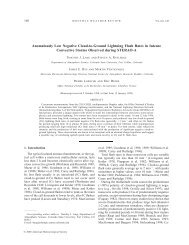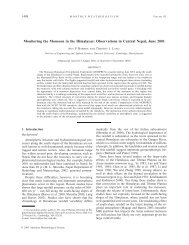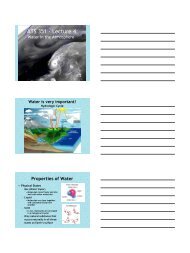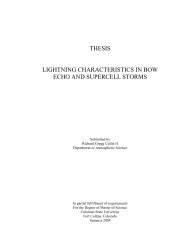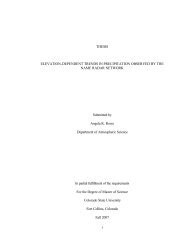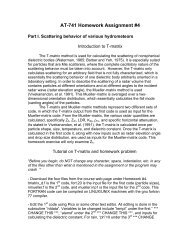1 A dual-polarization radar hydrometeor classification algorithm for ...
1 A dual-polarization radar hydrometeor classification algorithm for ...
1 A dual-polarization radar hydrometeor classification algorithm for ...
Create successful ePaper yourself
Turn your PDF publications into a flip-book with our unique Google optimized e-Paper software.
489490491492493494495496497498499500501502503504505506507508509510511A transition zone from convective rain to snow associated with a vertical bright band(Stewart 1992) propagated eastward through central Oklahoma prior to blizzard conditions on 24December 2009. The vertical bright band was easily detected in a reconstructed CASA <strong>radar</strong>RHI as an organized region of wet snow extending toward the ground in Fig. 10. The HCAanalysis matches METAR observations across this domain. Rain was reported at the <strong>radar</strong> sitewhile a transition to freezing rain, sleet, and then brief instances of snow were observed inadvance of the main vertical bright band (10-12 km range), with dry aggregated snowflakesconsistently falling in the cold air at increasing range. This illustrates the ability of the <strong>algorithm</strong>to differentiate heavy rain from wet snow, both of which produce high Z h and Z dr , based ondifferent expected ranges of ! HV . It also shows the melting layer detection <strong>algorithm</strong>’s versatilityin identifying a descending bright band by accounting <strong>for</strong> varying ML heights with range. Rainand sleet were classified as a function of temperature and there<strong>for</strong>e height using the 12 UTCupstream KOUN sounding. A refreezing signature indicative of sleet as described in Kumjian etal. (2013) was briefly observed ahead of the vertical bright band passage near the 0°C level in adifferent <strong>radar</strong> scan not shown, but the <strong>algorithm</strong> did not correctly classify this near-surfaceprocess as previously explained.Once the surface precipitation type changed to snow within the <strong>radar</strong> domain during thennext hour, particularly high K dp up to 2.6° km -1 was observed within a classic DGZ in Fig. 11.This exceeds the maximum X-band K dp expected <strong>for</strong> dendrites by 0.6° km -1 , perhaps becausethese dendrites exceeded the maximum diameter allowed in our scattering model (1 cm). Thehigh K dp -Z dr “pocket” and HCA dendrite identification in Fig. 11 was collocated with the -15°Cisotherm from a nearby sounding three hours prior. Wet snow is included in this HCA because atemperature inversion was still present but not strong enough to prevent snow from reaching the23



